
The salt marsh harvest mouse, also known as the red-bellied harvest mouse, is an endangered rodent endemic to the San Francisco Bay Area salt marshes in California. The two distinct subspecies are both endangered and listed together on federal and state endangered-species lists. The northern subspecies is lighter in color and inhabits the northern marshes of the bay, and the southern subspecies lives in the East and South Bay marshes. They are both quite similar in appearance to their congener species, the Western harvest mouse, R. megalotis, to which they are not closely related. Genetic studies of the northern subspecies have revealed that the salt marsh harvest mouse is most closely related to the plains harvest mouse, R. montanus, which occurs now in the Midwest. Its endangered designation is due to its limited range, historic decline in population and continuing threat of habitat loss due to development encroachment at the perimeter of San Francisco Bay.

The Neotominae are a subfamily of the family Cricetidae. They consist of four tribes, 16 genera, and many species of New World rats and mice, predominantly found in North America. Among them are the well-known deer mice, white-footed mice, packrats, and grasshopper mice.

The western harvest mouse is a small neotomine mouse native to most of the western United States. Many authorities consider the endangered salt marsh harvest mouse to be a subspecies, but the two are now usually treated separately.

Sumichrast's vesper rat is a rodent of the family Cricetidae found from southern Mexico to Panama. It is named for the collector of the first specimen, and its closest relative is probably Hatt's vesper rat, a similar, but slightly smaller, species from the Yucatán Peninsula.

Reithrodontomys is the genus of groove-toothed New World harvest mice.
The short-nosed harvest mouse is a species of rodent in the family Cricetidae found in Costa Rica and Nicaragua.
The Sonoran harvest mouse is a species of rodent in the family Cricetidae. It is found only in Mexico.
The Chiriqui harvest mouse is a species of rodent in the family Cricetidae. It is found in Costa Rica and Panama.
The fulvous harvest mouse is a species of rodent in the family Muridae. It is found in El Salvador, Guatemala, Honduras, Mexico, Nicaragua, and the United States.

The eastern harvest mouse is a species of rodent in the family Cricetidae. It is endemic to the Southeastern United States. Its natural habitats are subtropical or tropical seasonally wet or flooded lowland grassland, swamps, and pastureland.
The Mexican harvest mouse is a species of rodent in the family Cricetidae. It is found in Colombia, Costa Rica, Ecuador, El Salvador, Guatemala, Honduras, Mexico, Nicaragua, and Panama in a variety of habitats at altitudes from sea level to 3800 m.
The small-toothed harvest mouse is a species of rodent in the family Cricetidae. It is found in Guatemala and Mexico.
The Nicaraguan harvest mouse is a species of rodent in the family Cricetidae. It is found in Costa Rica and Nicaragua.
Rodriguez's harvest mouse is a species of rodent in the family Cricetidae. It is found only in Costa Rica.

The Cozumel harvest mouse is a species of rodent in the family Cricetidae. It is endemic to the Mexican island of Cozumel off the Yucatán Peninsula. It is nocturnal and semiareboreal, and lives in dense secondary forest and forest edge habitats. Its population is small, fluctuating and patchily distributed. The species is threatened by predation from feral cats and dogs and introduced boa constrictors, by competition with introduced nonnative rats and mice, and by habitat disturbances caused by hurricanes and floods which periodically strike the island.
Sumichrast's harvest mouse is a species of rodent in the family Cricetidae. It is found in Costa Rica, El Salvador, Guatemala, Honduras, Mexico, Nicaragua, and Panama.
R. gracilis may refer to:






